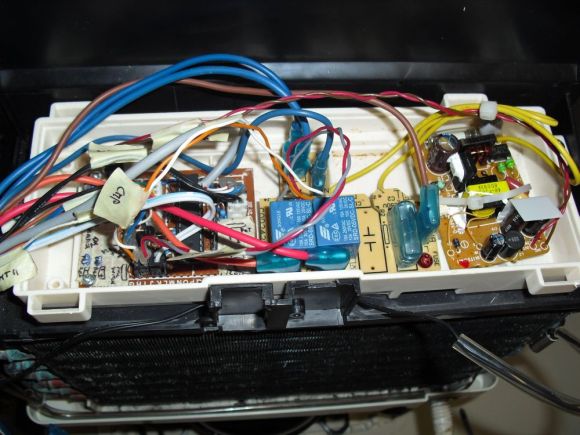
We’ve thought of doing a project like this ourselves as the dehumidifier we ordered online runs the fan 24/7 no matter what the humidity conditions. But it wasn’t that [Davide Gironi] was unhappy with the features on his unit. It’s that the dehumidifier controller stopped working so he replaced it with one of his own design. The original humidity sensor was mechanical and simply broke. He used an AVR along with a humidity and frost sensor to get the appliance up and running again.
A DHT22 humidity sensor is polled by the ATmega8 chip and compared to the user-adjustable trimpot value. If it is above that threshold the unit is switched on using one of the relays seen in the image above. The one problem you have to watch out for when using compressor cooled appliances is ice accumulation on the radiator. [Davide] uses a thermistor for temperature feedback, switching the compressor off when it gets below 7C and turning it back on again when it is above 12C.
The replacement still uses the reservoir sensor and indicator LEDs. We, however, would recommend using the watchdog timer on the chip to ensure that it is reset if something goes wrong in the code.














Just noticed this headline:
“Major brute force attack against WordPress underway”
Stay safe HaD.
There’s some rather simple and sound advise on reddit btw.
I’ve hacked air conditioners like this. Had one that took and electrical spike that fried the electrical components. So I just grafted a couple components in from a broken AC. They’re incredibly simple machines btw.
I live in East TN and my unit ices over a lot, I’d be interested to see a common Trane’s circuit diagram or mod walk through to fix.
furiousd, check your refrigerant charge.
Icing up is normally a symptom of a low refrigerant level
and possible leaks.
air at the evap coil should be around 34 deg F. any lower and you get icing or slushy conditions
which isolates the coil from the air flowing across it.
that said, it seems almost like units are being built
with a low charge nowdays
and just assuming that people never run them
at a cooler setting,
thus allowing the units to defrost between
compressor runs.
If you’re like me and turn the thermostat down
to get a cool dry house,They’ll frost over
and stay covered untill you turn up the stat a bit.
Low temperature where the dehumidifier is located will cause the coil to ice up. If the temp goes lower than about 65 degrees, ice will start to form. Here is how I solved the problem. I built a unit consisting of a mechanical thermostat meant for a furnace and air conditioner, and used only the air conditioner part. In addition I had to use a 24-volt transformer and a relay (actually a heavy duty relay called a contactor). When the temperature drops too low, the thermostat disconnects the dehumidifier from the power. It’s getting hard to find mechanical thermostats. New dehumidifiers already have the thermostat built in.
“The one problem you have to watch out for when using compressor cooled appliances is ice accumulation on the radiator.”
That’s problem #1. Problem #2 is to make sure that the compressor is never cycled too quickly. If the compressor cycle is shorter than the time needed for pressure equalization throughout the system, the compressor will be damaged.
Yeah – my Frigidaire dehumidifier implements a similar protection. If you were to plug it in and if it was left in the on condition, the compressor won’t start for several minutes. The problem being that there’s no way for the unit to know if there was a very short power outage that might lead to damaging the compressor. The best way to deal with it is to implement a minimum off time.
+1
so, is it better to implements a minimum OFF time, and also a minimum ON time, in your opinion? how much?
for problem #1 i’ve used an NTC thermistor bind to radiator (you can see in the picture above, on the right)
for problem #2 i’ve setup the off threshold, when ambient humidity reach humidity threshold dehumidifier start running, it stop running if ambient humidity goes below humidity threshold minus a constant humidity off range
dehumidifier is running for 4 month without freezing (i should say blocking:)), anyway a user suggest me to update the dht library to a non blocking one, so i do this.
any suggestion appriciated :)
Sounds like you’ve got it under control (pun intended).
as i write above, !suggestions! are appriciated :)
DHT22/RHT03… what a turd component. I use one for humidity and temp logging, but it goes into a death spiral of read errors and after about 40 minutes returns temp and humidity of 0 until it gets power cycled.
with my (only one tested) DHT22 i’ve not noticed this issue yes; it happens sometimes with DHT11 but after days of work.
it could be your DHT22 that is damaged, or mine manufacured better than other :)
So you base your opinion on a single experience?
no, of course :) maybe i’ve not expressed the concept in a perfect language, mine was not an opinion (about the DHT22), but a consideration based on experimental data respect on the hardware i’ve :)
I think cybergibbons was targeting me. Yes, mine was an opinion, based on anecdotal evidence (experiment with an n=1). I’ll stand by it until I get more compelling evidence… which in this case is someone else’s similar experiment with a similar sample size. I have altered my opinion: DHT22/RHT03: POSSIBLY a turd component.
You can find the updated version for this project here:
http://davidegironi.blogspot.it/2013/09/avr-atmega-dehumidifier-controller.html
It contains:
* Electromagnetic Interference fix
* DHT replacement
* watchdog control
* minimum on/off compresso time